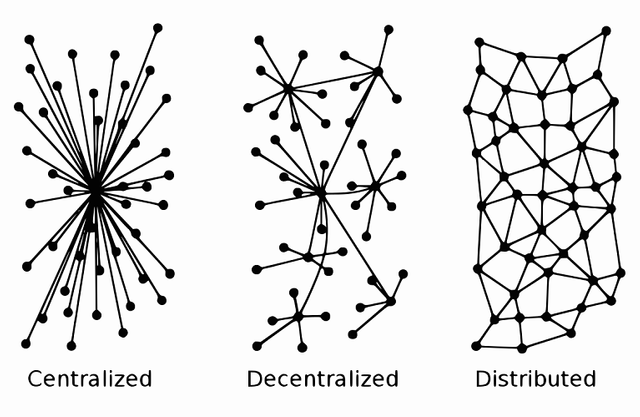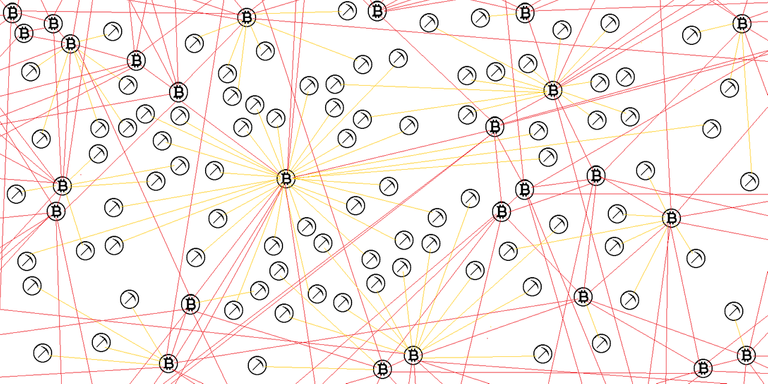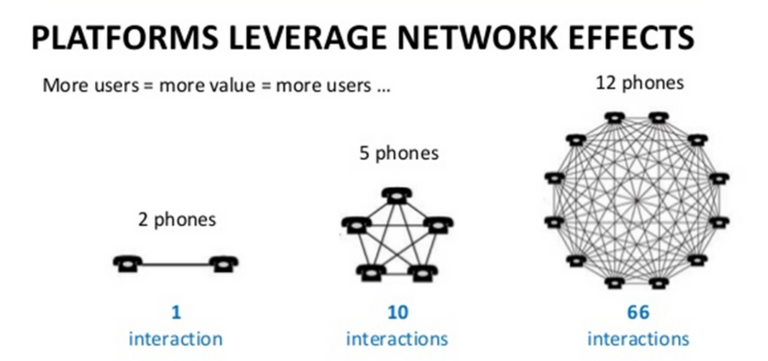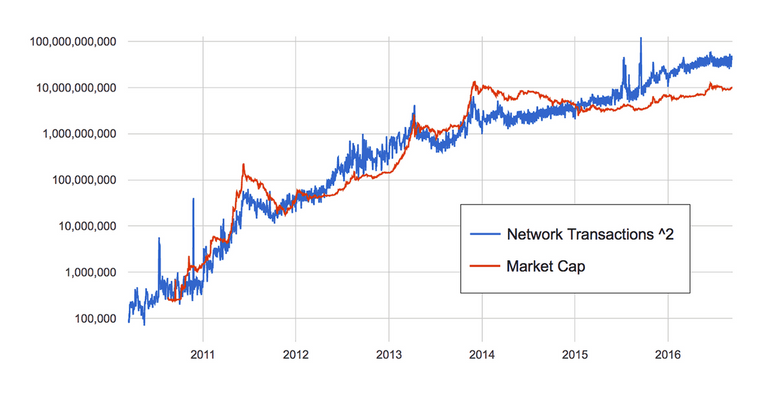A view over the Bitcoin network, its decentralization and antifragility
This article is about the Bitcoin network, its layers and their decentralization or centralization. It's the first bigger article I wrote about BTC and I decided to translate them also into English. We will talk about lightning, mining, networks, centralization, decentralization and antifragility. And about the hydra I used as a linguistic or metaphorical symbol for antifragility. I also used my Microsoft Paint skills to showcase some things. The force of Bitcoin hugely comes from its decentralization, so this was one of the first things I wrote about.
When discussing about Bitcoin, everything is also a question of how we look at things and what terms we use. For example you can hear or read the argument that there will be many central nodes with many channels in the Lightning network. And for many that sounds like centralization. Centralized points that could each represent a single point of failure. But that's exactly where the contrary statement lies: there are several central points. So no single point after all. In fact there is just a point of failure for the respective part of the network.
The lightning network is one of the most important developments in my opinion. Let's start with thinking about how a big Lightning Hub could do a fail.
They could close channels, of course. But why? For what reason? It doesn't give them any advantage. Unless they want to liquidate everything as quickly as possible and get out of Bitcoin. But who does that would certainly not have started to build a big hub in the first place. By definition, the operators of large Lightning Nodes are always also large stakeholders. Because they keep a lot of liquidity available in their channels and generally have a high effort to keep their systems running. Large companies such as Blockstream and various Exchanges will run such nodes. According to logic, these stakeholders - and consequently Bitcoin profiteers - are expected to behave in a way that is beneficial to the health of the entire network and ecosystem. As the same as it is true for the miners, who receive their profits in Bitcoin and would risk their future cash flow if they act against the welfare of BTC.
Let's consider whether mining and lightning are centralized or decentralized.
Miners usually stay in their pool all the time. Getting out of the pool would be very useless as the cash flow would become more irregular. The smaller the pool, the more irregular. For miners with more hash power it would be even less risky to join a smaller pool, but for smaller miners it is actually the logical choice to be a member of a large pool. However, the mining itself is not centralized.
It is not centralized, because the pools could form again and again and because there can be as many such pools as you like. If there wold be only one pool that determines everything - then centralization would exist. The determinants are distributed all over the world and from time to time it's everyone's turn to take over a block. The power is distributed, but the network structure, as it can be represented graphically - we'll come to that later - looks a bit like centralization.
Just as smaller miners connect to larger pools, lightning users will also find it more useful to connect to large nodes. Because they are likely to be connected to more merchants and exchanges. But here the necessity for that is much smaller. You can also connect to someone else whose personal network is connected to the big network. So here we have less tendency towards centralization than with the mining pools, if not even the possibility of a better distribution.
This seeming centralization or the creation of centralized subnetworks is what gives a better usability in both cases. Thats the blockchain trilemma. Sometimes you will have to sacrifire some decentralization for gaining usability. But regarding to that I think BTC provides us the best and most inexpensive conditions to do so.
There are three shapes a network can take: Centralized, decentralized and distributed.

For what does the "D" in "DLT" stand for? Yes "distributed" and "decentralized" - These two are often confused or used synonymously. Now I would like to consider the individual components of the Bitcoin system and then we will see which of the three "things" is more or less present.
The Bitcoin network has more or less all three characteristics. Depending on which area you look at and how you define the terms. It would only be full centralized if there were just one single lightning node and one single mining pool in the world. Or a single full node in which everyone has to trust. We are so far away from this, that we can consider Bitcoin to be the most secure, powerful and robust network out there in the entire world, when considering decentralization as a must have.
The peer to peer gossip network of Bitcoin full-nodes

To see here: The Bitcoin network as communication network - The basic structure for the communication between nodes. It is a distributed network. Of course these microsoft paint pictures are not a realistic but rather some simplified schemes to get an imagination of the bitcoin network. The circles with B's inside represent the BTC full nodes and the red lines are P2P connections via Internet. It is comparable to a torrent network over which data can be spread rapidly. Over this network, Bitcoin broadcasts transactions/messages and blocks. This fundament of the Bitcoin system is most closely related to the third picture, C on the right - it is a distributed peer-to-peer network. At least if you take out those users that trust a single node. But I didn't draw them into the picture. If I had drawn them in, it would remind me a bit more of the middle picture B. The importantce is that anyone of them can use any node to perform transactions or retrieve the blockchain. And also that everyone can run a node himself - complete freedom and equality for every participant.
Even if one would destroy, shut down or blow up nodes one after the other, this would do little damage to the entire network. Rather, the network or the people behind it will react and install and operate even more new nodes. The more heads you chop off the hydra, the more will re-grow.
Miners and mining pools
We now look at the network connections through which computing power is provided to mine new blocks. Everyone is allowed to submit a block into the network using any node within this network - if you mined a valid one. This is the way how energy flows into the bitcoin according to the proof of work model. We will take a look to this and its energy consumption in later articles, but now let me show how this looks topologically as it is integrated into the whole network.

I still put the BTC nodes in here as well. But this time the focus is on the miners, which are represented by the symbols, as they are connected to their pools. The pools, of course, use nodes to send in the mined blocks and select the transactions for these blocks. As said before, this is allowed to happen via any node. Absolute equality. If you have a block, you can send it in, of course. You just have to find such a block first. The golden connections to some of the nodes represent the connections between pools and miners, with the purpose to do exactly that.
Consensus building is decentralized. There is no single center where the entire consensus is created, but a few centers that have only emerged from voluntary associations. What looks like the center in this picture - let it be the btc.com Pool - can theoretically dissolve very quickly by the miners breaking their connection and simply joining somewhere else.
The computing power itself, on the other hand, is better distributed, as the distribution of the mining symbols on the picture should also represent. The actual power is therefore not located at the few central locations, but is distributed. It is only largely bundled at these central locations. Bitmain Technologies can be seen as the largest stakeholder and profiteer, whose hardware would be nothing but scrap metal without a valuable Bitcoin. And they probably won't "destroy" the whole thing. It is an industry that delivers hardware that can be used to participate in that system by spending electricity.
If you destroy a large mining pool or if such a pool proves to be untrustworthy, this does not affect the hash power as the miners will reconnect as fast as they can. And this probably with smaller pools than before, which leads to a better distribution of the shares between pools. So you could see an antifragility here as well.
Even when mining halls will burned down or blown up - When the biggest mining hall is destroyed there will remain more halls with less share. So it would result in a better distribution between partys when someone attacs the biggest head of the hydra.
The Lightning Network

Then I finally made another picture which shows a small part of the lightning network, how you could imagine it graphically if it will be like this in the future.
Here we also see several centers again. It is clear that these large nodes will be formed. However, there will be much more of these large nodes than there are mining pools. Probably many Exchanges will build lightning nodes, as well as different companies with customers in crypto space. So there will be many more different centers than it is the case with mining. More different centers does not mean more centralization but more decentralization. That's why I see the lightning network as an advance in decentralization for the entire BTC ecosystem.
Such a system of super hubs will support a behavior of entrusting oneself to a single node. But the possibility to run your own, smaller node is always there. I am also thinking about mobile nodes that would be much easyer to run using better storing- and 5G-technology on mobile devices with integrated hardwallets.
There is no reason to found a small mining pool with a handful of miners. The urge towards a more centralized looking structure is very strong. Within the lightning network such an urge is not so strong - the emergence of many small nodes is very probable. There will be a lot of them, much more than there will be big nodes. Rather, such multi-stage clusters will emerge, with numerous centers connected to each other. Exactly as it can be seen simplified on the middle picture B "decentralization". So the number of full nodes will also increase. This again improves the P2P communication network, on which we took a look before, and makes the whole thing more robust and distributed. Now that the opportunity to earn as a lightning node operator has been created, there is an monetary incentive to operate a full node to provide liquidity and build an subnetwork by acquiring more users.
The better these fundamentals, the better for Bitcoin as a payment network. As the number of nodes increases, the utility of both the P2P network and the LN network increases exponentially and so welcome to Metcalfe's Law!

(Source, The more users/nodes it contains, the more utility value does a network provide)
To reach a better value of usage for Bitcoin we need more nodes, more possible transactions per second and more Users. That's exactly what the lightning network can serve for, without loosing so much decentralization as by custodial wallet solutions. Even after Bitcoin comes to its limit of on-chain-transactions in its first layer.

You can assume that large amounts of Bitcoins monetary worth comes out of its worth of usage that can be calculated following metcalfe's law. Even if it is not so much correlating anymore, since the store of value aspect came into Bitcoin too.
Bitcoin can of course also be digital gold as it is now. If, on the other side, you assume that an average normal user, who wants to use this innovative thing called "Bitcoin" as money, wants to execute a certain number of transactions per time unit, then above a certain maximum number of users, this is not scalable because of the blockchain bottleneck. However, Lightning can do something to end this.
If you destroy (we always have to start from the extreme case :D) a super hub or if it fails, all those who have connected themselves exclusively to this node would have to reconnect. This is not as easy with Lightning Channels as with a connection between a miner and its Pool, because an on-chain-transaction is necessary. So it would require a certain time of regeneration in such an event, depending on the amount of damage. But in the end there would probably be a more decentralized and better distributed and therefore more solid network than before. The incident would presumably also lead to more users deciding to run nodes themselves. So I see a network that can become more powerful if someone tries to attack it or if system failures occurring at critical points. This is exactly what antifragility means.
"What can’t kill Bitcoin, makes it stronger."
(Mark Wittkowski)
You can see this possible behavior of antifragility not just within the topology of the individual network components, but also within the community - In the course of the market cycles in which Bitcoin was declared as "dead" several times, those holders with highest time horizons and strongest visions survived. This almost seems like an organism in which cells that are harmed by external influences die so that the whole biological system becomes stronger. What is referred as death in this case is actually a process of improvement...
The concept of antifragility also applies to the necessary reputation and awareness of BTC. As soon as a politician makes a fool of himself by banning Bitcoin, it attracts more attention to BTC. If some one yells "ZERO", the price does the opposite. If the Chinese government bans the currency, the Chinese are even more willing to start trading with it. If a mad fake-Satoshi trolls the entire community, maybe it triggers panic at first, but in the end BTC is stronger than before. If a government tries to introduce some kind of bullshit currency (the oil-backed "Petro" in Venezuela), the citizens try to do their daily business with real cryptocurrency instead. So what will happen when lightning is developed and ready to operate for millions of people?
The Hydra just has to be awakened to life, and then ragnarök will follow for previous archaic monetary systems. Oh, sorry I mistaked the Hydra with the Midgard Serpent :D

"Hydra" is also the term for the freshwater polyp. Of course they are much smaller and built completely different, but these animals look a bit like the mythological Hydra.

(Source)
The hydra owns a diffuse neural system. So a neural system that can work without a central unit like a brain, from where everything is controlled. We could also say that it is a decentralized / distributed neural network. These animals have an extremely high regenerative potential. It is even possible that a part of the Hydra, that was separated from the organism, will turn into a new, complete Hydra. Is Bitcoin immortal and indestructible due to its decentralized nature similar to the Hydra?
Intentions of this article
Yes, I'm writing this all deliberately so that it's hard to understand. :D I'm not sure how it's supposed to work differently with this topic. I want to be bullish for Bitcoin without mentioning any amounts of money and without waving charts around like some Crypto-Youtubers do, but rather by going deep into the topic and accepting that I might create more confusion for some readers first. I also hope that my English skills don't make that so much more worse.
The aim of articles like this is to increase enthusiasm and insight for Bitcoin and its characteristics, like decentralization or antifragility in this case, or to trigger off discussions which lead to this. The overall conclusion is, that there is more or less centralization, decentralization or distribution, depending on how we define these terms and on which part of Bitcoins network we are looking at the same time. Maybe not a fully satisfying level of decentralization for all layers and users, but the best we can deal with.
Later probably I will go ahead by translating my second bitcoin-article which is about why Bitcoin seems to be a perfected form of gold. At this time there are three Bitcoin-articles I made and this was the first one. Here you will get to my original German article about antifragility and decentralization of Bitcoins network.
I really like the hydra analogy :D
@tipu curate
Upvoted 👌 (Mana: 12/28)
Thank you. It is a reference to biology+mythology(another two completely different topics). I like it to connect things this way.
Yea I and also already ancient egypts liked that idea :D
They've put all their knowledge and maths into mythology and tell us about it in their symbols. :)
Thanks! Interesting article. Upvoted and resteemed.
I really hope they soon combine Lightning with PayNym by for example Samourai :]
Posted using Partiko Android
I did not heard about paynym yet, but I think every innovation for LN is desirable.
Maybe it is also possible to build private(like Monero and Zcash) blockchains/sidechains based up on the original chain by pegging the tokens with BTC. Such as Liquid or Binance chain. So in fact using BTC as standard for funding/backing additional transaction systems.
Paynym is not a LN innovation. It works without LN but I HOPE it will soon also work with LN. ;)
I don't think there will be private sidechains possible.. cuz if some BTCs are private, you don't know how many BTC there are exactly right now.
That's why Grin is never going to be a Store of Value. But as private medium of exchange the exact amount isnt that important as for BTC (cuz of SoV).
:]